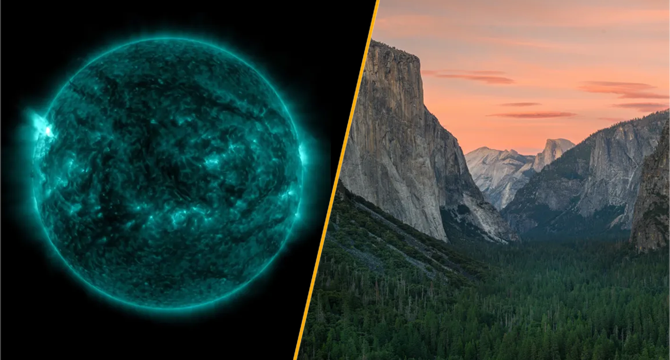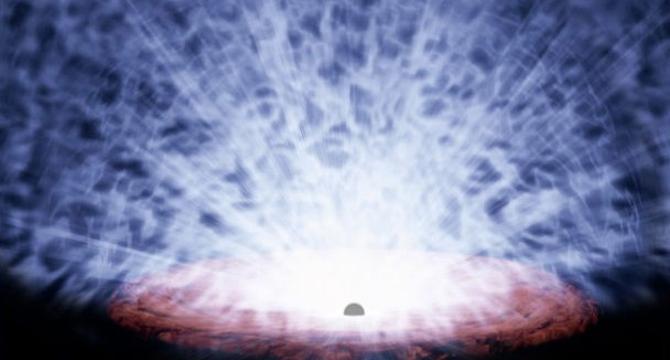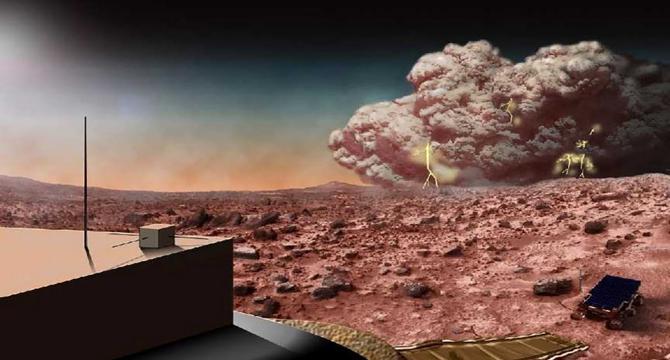Space News
Earthsky
395

Image Credit: Earthsky
How cuts to science in the US endanger everyone
- Cuts to science in the United States, particularly at the National Science Foundation (NSF), pose a severe threat to research that enhances economic growth, national security, and public safety.
- NSF funding has played a crucial role in developing technologies like touch screens, speech recognition, and internet, and has contributed to advancements in earthquake-resistant buildings and storm monitoring.
- Proposed budget cuts could lead to a significant reduction in funding (by 55%) for NSF, jeopardizing research in various disciplines and potentially causing scientists to leave the field.
- NSF's past contributions include supporting research on natural hazards, space exploration, and national defense, with a significant return on investment of 150% to 300% for taxpayers.
- The history of NSF's establishment during the Cold War era highlights the importance of science in national defense and prosperity.
- Currently, NSF funding impacts every state in the U.S., supporting research projects that drive local economies and create employment opportunities.
- Cuts to NSF grants not only affect scientific research but also have severe economic repercussions, leading to job losses and reduced productivity.
- The termination of over 1,400 NSF grants underlines the uncertain future of American science, with a potential decline in highly skilled scientific workforce and innovation.
- Scientists are responding to these challenges by contesting grant terminations, contemplating career shifts, or considering opportunities abroad, which could further impact the nation's scientific leadership.
- Maintaining funding for science and engineering is essential to safeguarding America's future in facing climate challenges, pandemics, and resource limitations.
Read Full Article
23 Likes
Earthsky
378

Image Credit: Earthsky
Meet lovable, easy-to-find Corvus the Crow
- Corvus the Crow is a small constellation that represents a crow and can be easily found near the bright star Spica, which is in the constellation Virgo.
- The constellation Corvus is known for its boxy shape and is often depicted as a crow pecking towards Spica.
- Corvus has various legends associated with it, including being seen as an imperial chariot in Chinese mythology and a cupbearer to Apollo in Greek mythology.
- The constellation Corvus contains bright stars like Gienah, Beta Corvi, Algorab, and Epsilon Corvi, each located at different distances from Earth.
- Corvus is also home to deep-sky objects like the Antennae Galaxy and the planetary nebula NGC 4361, best viewed with telescopes in dark skies.
- Observers can use Spica to easily locate Corvus in the night sky and explore its stars and deep-sky objects.
- Corvus and other celestial objects like Crater the Cup and Hydra can be seen in the May evening sky.
- Folklore about Corvus varies across different cultures, adding to the charm and fascination of this easy-to-find constellation.
- Two star clusters, NGC 4038 and NGC 4039, known as the Antennae Galaxy, are among the notable deep-sky objects in Corvus.
- Corvus offers stargazers a delightful viewing experience, especially when paired with the bright star Spica for guidance.
Read Full Article
22 Likes
Livescience
159

Image Credit: Livescience
Our moon may have once been as hellish as Jupiter's super volcanic moon Io
- New research suggests that the moon's orbit could have turned it into a molten monster resembling Jupiter's moon Io, with ongoing volcanic activity for a few million years.
- A massive protoplanet collision with Earth led to the formation of the moon, causing it to drift away and solidify over time.
- The moon's orbit was influenced by the sun's gravity, resulting in a gravitational mishmash that led to volcanic eruptions on the moon.
- Gravitational forces churned up the lunar interior, creating a magma layer that erupted to the surface, resetting the lunar surface about 4.35 billion years ago.
- Methods to determine the moon's age include analyzing moon rocks, lunar zircons, and dynamical models, suggesting an age of around 4.35 billion years.
- Volcanism on the moon would have lasted for tens of millions of years, with lava seeping through the surface rather than forming mountains.
- The moon's volcanism may have inhibited the formation of a magma ocean layer, with liquid material rising through the crust.
- During this period, the moon would have appeared larger in the Earth's sky, with glowing lava flows visible.
- The Io-like volcanic phase on the moon lasted for a brief but energetic period of a few tens of millions of years.
- The moon's volcanic past sheds light on its tumultuous history and the processes that shaped its surface over billions of years.
Read Full Article
9 Likes
Livescience
116

Image Credit: Livescience
Science news this week: 2025's biggest solar flare and Yosemite's 'ghost' volcano
- The strongest solar flare of 2025 occurred on May 14, following another powerful X-class flare on May 13.
- Experts warn about the U.S. being unprepared for major solar storms as solar activity increases.
- A U.S. baby became the first to receive a CRISPR-based gene therapy targeting a specific mutation.
- The baby, born with a rare genetic disorder, received personalized treatment and is now thriving.
- Math's origins and development, ranging from counting to complex calculus, continue to be a topic of interest.
- Research suggests Yosemite's deep canyons may have been carved by an ancient volcano and river.
- In other news, physicists are exploring a potential 'theory of everything', while the deep ocean remains mostly unexplored.
- A study claiming trees 'talk' before solar eclipses has faced skepticism from the scientific community.
- Interesting long reads, environmental photography awards, and skywatching tips add to the world of science this week.
- A video capturing the ground tearing apart during a major Myanmar earthquake offers new insights into seismic events.
Read Full Article
6 Likes
Discover more
Medium
305

Image Credit: Medium
How I Made Stunning Movies with AI Technology
- AI MovieMaker is a tool that generates ultra-realistic 8K cinematic movies, revolutionizing video creation.
- Using AI MovieMaker, individuals without prior video editing experience can create captivating videos quickly and easily.
- Users have seen increased engagement and opportunities for monetization after using AI MovieMaker for their video projects.
- AI MovieMaker is a valuable tool for various industries, offering possibilities for businesses, educators, and individuals to enhance their digital presence.
Read Full Article
18 Likes
Livescience
275

Image Credit: Livescience
NASA spacecraft snaps eerie image of eclipsed sun with an extra moon overhead. What's going on?
- NASA's PUNCH mission captured a captivating image of the sun's corona with the moon overhead on April 27.
- PUNCH mission, aiming to study the solar wind, involves four small satellites orbiting Earth to observe the sun and space between it and Earth.
- The recent photo taken during the commissioning phase shows the sun's corona with an occulter shadow, enabling the study of solar wind and its implications on Earth.
- The mission's images will provide insights into the sun's corona, aiding in understanding geomagnetic storms and protecting Earth from space weather effects.
Read Full Article
16 Likes
Nasa
111

Image Credit: Nasa
Friday is Full of Advancing Dragon Cargo Stowage, Advanced Research, and Maintenance of Orbital Systems
- NASA astronauts aboard the International Space Station worked on stowing and transferring cargo inside the SpaceX Dragon spacecraft.
- NASA astronaut Jonny Kim conducted experiments with the Advanced Space Experiment Processor (ADSEP-4) to potentially scale up pharmaceutical production in space.
- Expedition 73 crew members conducted maintenance on the Environmental Health System’s (EHS) Exploration Potable Water Dispenser and worked on deploying the Life Sciences Glovebox (LSG) for 3D imaging of microorganisms in space.
- The station's cosmonauts continued Russian segment maintenance, including tasks related to a nuclear physics experiment and the ventilation system connecting the Russian and U.S. segments.
Read Full Article
6 Likes
Nasa
211

Image Credit: Nasa
Nancy Grace Roman’s 100th Birthday
- Dr. Nancy Grace Roman, NASA's first Chief of Astronomy and namesake of the Nancy Grace Roman Telescope, would have celebrated her 100th birthday on May 16, 2025. She passed away on December 25, 2018, at the age of 93.
- Before joining NASA in 1959, Dr. Roman was a prominent astronomer who published influential papers in the mid-20th century. She played a vital role in gaining support for space-based observatories and made significant contributions to the development of the Hubble Space Telescope.
- Dr. Roman's work at NASA included establishing scientific ballooning and airborne science programs, initiating the Great Observatory program, and investing in technology like charge-coupled devices used in digital cameras today.
- After retiring, Dr. Roman dedicated her time to mentoring students in underserved communities, aiming to inspire them to pursue careers in STEM fields and contribute to humanity's quest for knowledge.
Read Full Article
12 Likes
Livescience
236

Image Credit: Livescience
'Yet another miracle save': NASA engineers complete nail-biting maneuver to resurrect Voyager 1's long-dead thrusters
- NASA engineers have successfully revived Voyager 1's long-dead thrusters, providing a crucial backup just before a planned communications blackout.
- This fix has extended the spacecraft's operation until contact with Earth is reestablished next year.
- Launched in 1977, Voyager 1 is over 15 billion miles away from Earth and requires 23 hours for a radio signal to reach our planet.
- The backup thrusters on Voyager 1 had been clogging up with propellant residue, posing a challenge for the spacecraft's orientation.
- Despite facing issues since 2004, Voyager 1 continued its journey into interstellar space, providing valuable data about conditions outside the heliosphere.
- NASA engineers had to resort to remote fixes due to the craft's high speed and remoteness in interstellar space.
- A critical antenna upgrade and looming backup thruster issues prompted NASA engineers to take immediate action to fix the heaters remotely.
- The engineers successfully fixed the thruster heaters, ensuring Voyager's continued operation beyond the potential antenna blackout.
- The team's efforts were praised as another 'miracle save for Voyager,' prolonging the spacecraft's mission despite inevitable instrument shutdowns.
- As Voyager 1 and Voyager 2 continue their journeys, the spacecraft face diminishing power reserves and impending shutdowns.
Read Full Article
14 Likes
Nasa
224

Image Credit: Nasa
NASA, International Astronauts Address Students from New York, Ohio
- NASA astronauts Nichole Ayers and JAXA astronaut Takuya Onishi will be answering students' questions from New York and Ohio in two separate events.
- The first event on May 20 involves students from Long Beach Middle School in Lido Beach, New York, and the second event on May 23 includes students from Vermilion High School in Vermilion, Ohio.
- Both events will be livestreamed on NASA STEM YouTube Channel for 20 minutes each.
- The astronauts aboard the International Space Station engage in educational outreach to inspire and educate students, promoting interest in STEM career pathways and highlighting the importance of space exploration.
Read Full Article
13 Likes
Knowridge
305

Image Credit: Knowridge
A black hole is firing bullet-like blobs of gas into space
- Black holes, known for their extreme gravitational pull, play a crucial role in shaping the universe.
- Gas winds expelled from regions around black holes are key to understanding their impact on galaxy evolution.
- Recent research led by Japan's space agency discovered rapid-fire gas 'bullets' with significant energy in these outflows.
- This finding challenges existing theories and provides new insights into the relationship between black holes and galaxies.
Read Full Article
18 Likes
Armaghplanet
224

Image Credit: Armaghplanet
April Weather Round-Up
- April 2025 was a record-breaking month at Armagh Observatory, being much warmer, sunnier, and wetter than average.
- It was the third warmest April on record with a mean temperature of 10.75 degrees Celsius, significantly warmer than historical averages.
- Daily maximum temperatures were notably high due to strong sunshine, making it the third highest average on record.
- Conversely, the average of daily temperature minima was only slightly above the 30-year average, indicating cool nights.
- The warmest day in April was 23.4 degrees Celsius, setting a new record for the month at Armagh.
- The month experienced high precipitation levels, with the wettest day being the 22nd, and overall precipitation was 64.8 mm.
- April was very sunny with 212.0 hours of strong sunshine, making it the third sunniest April on record.
- The first 11 days of April were exceptionally sunny, producing an average of 10.6 hours of strong sunshine per day.
- Armagh Observatory recorded no named storms but mostly dry days with high atmospheric pressure in April.
- These weather observations are significant as they provide insights into the unusual weather patterns during April 2025 in Armagh.
Read Full Article
13 Likes
Astronomynow
56

Universe’s end – sooner rather than later
- Dutch researchers propose universe could decay in roughly 10^78 years, compared to 10^100 years previously believed, based on reinterpretation of Hawking radiation.
- According to the new theory, all massive objects with a gravitational field, including white dwarfs and neutron stars, would vanish sooner than expected, with white dwarfs lasting only 10^78 years.
- No matter the density or mass, all objects, including the Moon or human body, will eventually evaporate via this universal radiation concept in about 10^90 years.
- Implications of this research go beyond changing the cosmic timeline, potentially bridging the gap between quantum mechanics and general relativity, hinting at spacetime being fundamentally quantum and providing a new path towards a theory of quantum gravity.
Read Full Article
3 Likes
Brighter Side of News
289

Image Credit: Brighter Side of News
New study finds ancient Mars likely had rainfall, snow and flowing rivers
- Recent research suggests that ancient Mars had a climate capable of supporting rainfall, snow, and flowing rivers billions of years ago.
- Valley networks on Mars hint at a planet with an active climate and possibly precipitation, contrary to previous cold and icy climate models.
- The study used computer simulations to compare theories of ice melting versus precipitation in forming Martian valleys.
- Evidence points towards precipitation being the more likely scenario for the formation of valleys on Mars.
- The Noachian epoch, when these valleys formed, dates back 4.1 to 3.7 billion years, during a time when Mars received less sunlight.
- The study suggests that deep valleys on Mars required prolonged water flow, indicating a hydrologic cycle similar to Earth's.
- Simulations showed that valleys at various elevations on Mars matched more closely with the precipitation model than the ice-melt model.
- The findings imply that ancient Mars might have had habitable conditions and stable environments for potential microbial life.
- Studying Mars could provide insights into early Earth's conditions and the origins of life on our own planet.
- Future missions like NASA's Perseverance rover will further contribute to understanding Mars' past climate and potential for supporting life.
Read Full Article
17 Likes
Livescience
133

Image Credit: Livescience
Best telescopes for kids 2025: A stargazing introduction for budding astronomers
- When choosing the best telescopes for kids, factors to consider include the child's age, interest in astronomy, and budget constraints.
- Ease of use and affordability are key considerations for selecting a telescope for children.
- Eight favorite telescopes for kids are highlighted, ranging from options suitable for all ages to those tailored for specific age groups.
- The Celestron Inspire 100AZ is recommended as the best overall telescope for kids, offering lightweight design, quality optics, and great views of the night sky.
- Budget-friendly options like the Hexeum Telescope and educational choices like the Leapfrog Magic Adventures Telescope are also featured.
- The NASA Lunar Telescope provides inexpensive yet fantastic views of the moon's surface, perfect for young children.
- The Vaonis Hestia stands out as a unique smart telescope that operates using a smartphone, making stargazing easier and more interactive.
- For preschoolers, the LeapFrog Magic Adventures Telescope offers a fun introduction to astronomy with a built-in digital screen for easy viewing.
- Teenagers can explore the night sky with the Celestron AstroMaster 70AZ, which provides good quality views of planets and nearby objects.
- Key factors in choosing a telescope for kids include ease of use, budget, optics quality, and suitability for different age groups.
Read Full Article
8 Likes
For uninterrupted reading, download the app